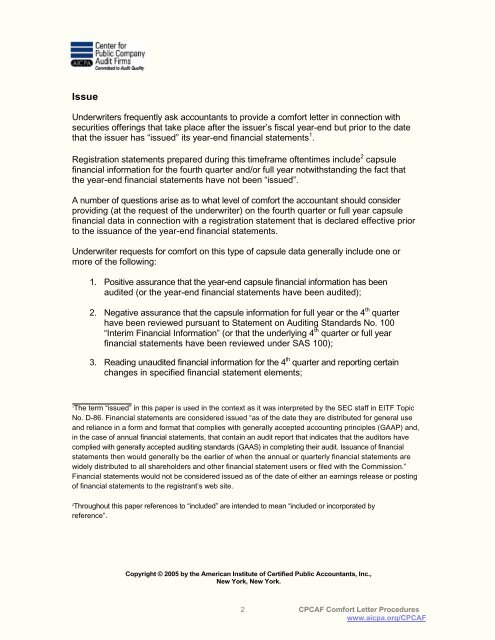Comfort Letter Procedures Relating to Capsule Financial Information ...
Comfort Letter Procedures Relating to Capsule Financial Information ...
Comfort Letter Procedures Relating to Capsule Financial Information ...
Create successful ePaper yourself
Turn your PDF publications into a flip-book with our unique Google optimized e-Paper software.
Issue<br />
Underwriters frequently ask accountants <strong>to</strong> provide a comfort letter in connection with<br />
securities offerings that take place after the issuer’s fiscal year-end but prior <strong>to</strong> the date<br />
that the issuer has “issued” its year-end financial statements 1 .<br />
Registration statements prepared during this timeframe oftentimes include 2 capsule<br />
financial information for the fourth quarter and/or full year notwithstanding the fact that<br />
the year-end financial statements have not been “issued”.<br />
A number of questions arise as <strong>to</strong> what level of comfort the accountant should consider<br />
providing (at the request of the underwriter) on the fourth quarter or full year capsule<br />
financial data in connection with a registration statement that is declared effective prior<br />
<strong>to</strong> the issuance of the year-end financial statements.<br />
Underwriter requests for comfort on this type of capsule data generally include one or<br />
more of the following:<br />
1. Positive assurance that the year-end capsule financial information has been<br />
audited (or the year-end financial statements have been audited);<br />
2. Negative assurance that the capsule information for full year or the 4 th quarter<br />
have been reviewed pursuant <strong>to</strong> Statement on Auditing Standards No. 100<br />
“Interim <strong>Financial</strong> <strong>Information</strong>” (or that the underlying 4 th quarter or full year<br />
financial statements have been reviewed under SAS 100);<br />
3. Reading unaudited financial information for the 4 th quarter and reporting certain<br />
changes in specified financial statement elements;<br />
1 The term “issued” in this paper is used in the context as it was interpreted by the SEC staff in EITF Topic<br />
No. D-86. <strong>Financial</strong> statements are considered issued “as of the date they are distributed for general use<br />
and reliance in a form and format that complies with generally accepted accounting principles (GAAP) and,<br />
in the case of annual financial statements, that contain an audit report that indicates that the audi<strong>to</strong>rs have<br />
complied with generally accepted auditing standards (GAAS) in completing their audit. Issuance of financial<br />
statements then would generally be the earlier of when the annual or quarterly financial statements are<br />
widely distributed <strong>to</strong> all shareholders and other financial statement users or filed with the Commission.”<br />
<strong>Financial</strong> statements would not be considered issued as of the date of either an earnings release or posting<br />
of financial statements <strong>to</strong> the registrant’s web site.<br />
2Throughout this paper references <strong>to</strong> “included” are intended <strong>to</strong> mean “included or incorporated by<br />
reference”.<br />
Copyright © 2005 by the American Institute of Certified Public Accountants, Inc.,<br />
New York, New York.<br />
2 CPCAF <strong>Comfort</strong> <strong>Letter</strong> <strong>Procedures</strong><br />
www.aicpa.org/CPCAF




